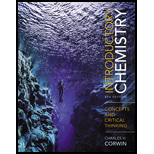
Concept explainers
(a)
Interpretation:
The volume in milliliters of given solid is to be calculated.
Concept introduction:
The density is defined as the ratio of mass of a body to its volume. For solid bodies densities are usually expressed in the units of grams per cubic centimeter, for liquids in the units of grams per milliliter and for gases in units of grams per liter.
(b)
Interpretation:
The volume in milliliters of given solid is to be calculated.
Concept introduction:
The density is defined as the ratio of mass of a body to its volume. For solid bodies densities are usually expressed in the units of grams per cubic centimeter, for liquids in the units of grams per milliliter and for gases in units of grams per liter.
Want to see the full answer?
Check out a sample textbook solution
Chapter 2 Solutions
Introductory Chemistry: Concepts and Critical Thinking Plus MasteringChemistry with eText -- Access Card Package
- Which part of the description of a compound or element refers to its physical properties and which to its chemical properties? (a) Calcium carbonate is a white solid with a density of 2.71 g/cm3. It reacts readily with an acid to produce gaseous carbon dioxide. (b) Gray, powdered zinc metal reacts with purple iodine to give a white compoundarrow_forwardWhat properties distinguish solids from liquids? Liquids from gases? Solids from gases?arrow_forwardA solid white substance A is heated strongly in the absence ofair. It decomposes to form a new white substance B and a gas C.The gas has exactly the same properties as the product obtainedwhen carbon is burned in an excess of oxygen. Basedon these observations, can we determine whether solids Aand B and gas C are elements or compounds?arrow_forward
- Suppose the metallic paper clips (which contain iron) had been replaced by magnesium or nickel. Would using a magnet as a method of separation have worked?arrow_forward• What is the density in g/cm^3 of 255g of solid metal with the volume of 41cm^3?arrow_forwardA solid white substance A is heated strongly in the absence of air. It decomposes to form a new white substance B and a gas C. The gas has exactly the same properties as the product obtained when carbon is burned in an excess of oxygen. Based on these observations, can we determine whether solids A and B and gas C are elements or compounds? Explain your conclusions for each substance.arrow_forward
- When a piece of aluminum is placed in a 25-mL graduated cylinder that contains 10.5 mL of water, the water level rises to 13.5 mL. What is themass of the aluminum?arrow_forwardThe diagram shown first represents solid carbon dioxide, also known as dry ice. Which of the other diagrams best represents the dry ice after it has sublimed into a gas?arrow_forwardWhich of the following is a chemical property of Sodium?A.melts at 60°CB.soft solid C.density of 11.4 g/mL D.Reacts violently with waterarrow_forward
- Which of the following is a homogeneous mixture? a) water and sand b) water and salt c) water and cooking oil d) a hard-boiled eggarrow_forwardSuppose that instead of using the cylindrical rod of Example 1-2 to prepare a 1.000 kg mass we were to use a solid spherical ball of copper. What must be the radius of this ball? (d = 8.96g)arrow_forwardSuppose that instead of using the cylindrical rod of Example 1-2 to prepare a 1.000 kgmass we were to use a solid spherical ball of copper What must be the radius of this ball?arrow_forward
 General Chemistry - Standalone book (MindTap Cour...ChemistryISBN:9781305580343Author:Steven D. Gammon, Ebbing, Darrell Ebbing, Steven D., Darrell; Gammon, Darrell Ebbing; Steven D. Gammon, Darrell D.; Gammon, Ebbing; Steven D. Gammon; DarrellPublisher:Cengage Learning
General Chemistry - Standalone book (MindTap Cour...ChemistryISBN:9781305580343Author:Steven D. Gammon, Ebbing, Darrell Ebbing, Steven D., Darrell; Gammon, Darrell Ebbing; Steven D. Gammon, Darrell D.; Gammon, Ebbing; Steven D. Gammon; DarrellPublisher:Cengage Learning Chemistry by OpenStax (2015-05-04)ChemistryISBN:9781938168390Author:Klaus Theopold, Richard H Langley, Paul Flowers, William R. Robinson, Mark BlaserPublisher:OpenStax
Chemistry by OpenStax (2015-05-04)ChemistryISBN:9781938168390Author:Klaus Theopold, Richard H Langley, Paul Flowers, William R. Robinson, Mark BlaserPublisher:OpenStax General, Organic, and Biological ChemistryChemistryISBN:9781285853918Author:H. Stephen StokerPublisher:Cengage Learning
General, Organic, and Biological ChemistryChemistryISBN:9781285853918Author:H. Stephen StokerPublisher:Cengage Learning Chemistry & Chemical ReactivityChemistryISBN:9781337399074Author:John C. Kotz, Paul M. Treichel, John Townsend, David TreichelPublisher:Cengage Learning
Chemistry & Chemical ReactivityChemistryISBN:9781337399074Author:John C. Kotz, Paul M. Treichel, John Townsend, David TreichelPublisher:Cengage Learning Chemistry & Chemical ReactivityChemistryISBN:9781133949640Author:John C. Kotz, Paul M. Treichel, John Townsend, David TreichelPublisher:Cengage Learning
Chemistry & Chemical ReactivityChemistryISBN:9781133949640Author:John C. Kotz, Paul M. Treichel, John Townsend, David TreichelPublisher:Cengage Learning Introductory Chemistry: An Active Learning Approa...ChemistryISBN:9781305079250Author:Mark S. Cracolice, Ed PetersPublisher:Cengage Learning
Introductory Chemistry: An Active Learning Approa...ChemistryISBN:9781305079250Author:Mark S. Cracolice, Ed PetersPublisher:Cengage Learning





